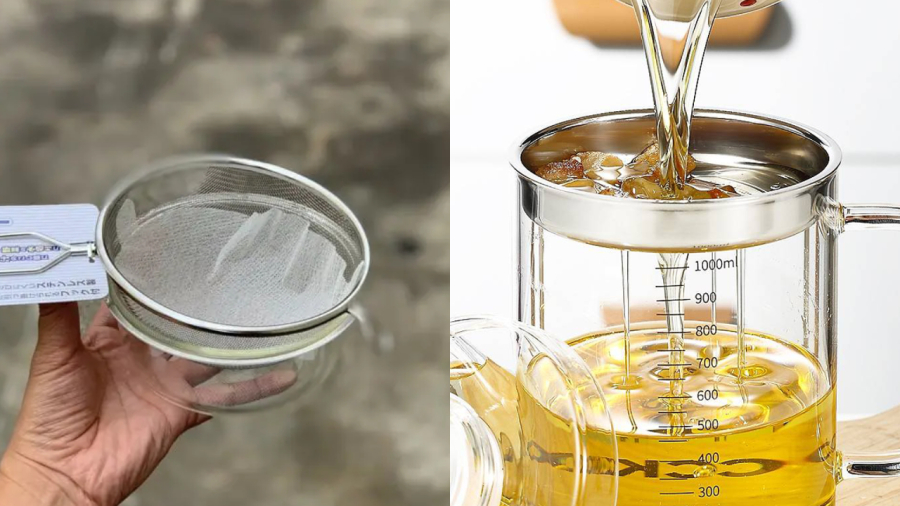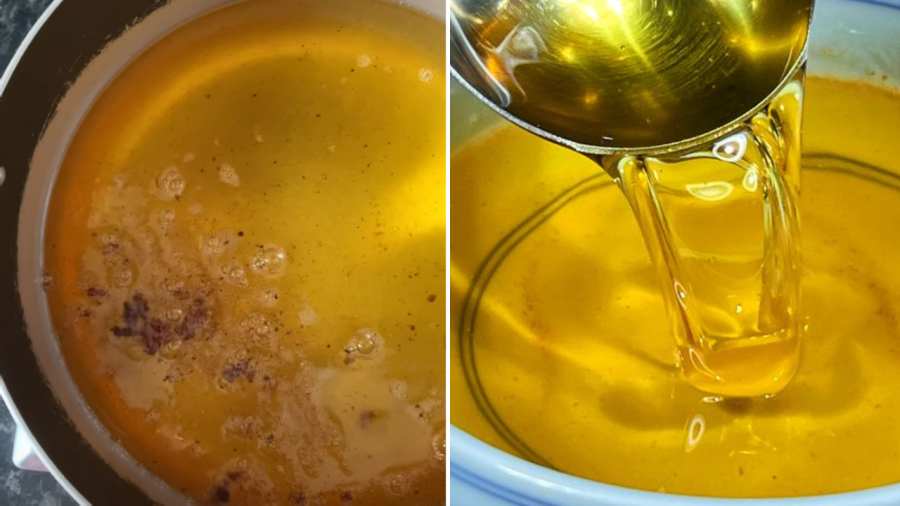**Tips for Filtering Fried Cooking Oil Quickly**
For fried foods, using ample oil ensures even cooking and a crisp texture. However, discarding this oil after one use is wasteful. Oil contains food residue, so reusing it without proper treatment can lead to burnt, unappetizing, and potentially unhealthy fried foods. To remove food residue from used cooking oil, consider the following methods:
– **Use a Strainer**: Allow the oil to cool completely, then pour it through a fine-mesh strainer to catch larger food particles. For increased effectiveness, line the strainer with coffee filters or cheesecloth, which will trap smaller particles that the strainer might miss.

Using a strainer or filter paper to remove food residue from used cooking oil.
– **Cornstarch Method**: Dissolve a spoonful of cornstarch in about 60ml of water and pour this mixture into the oil. Slowly heat the oil over low heat while stirring continuously. The cornstarch will attract and absorb the residue in the oil.

Cornstarch can effectively remove food residue from used cooking oil.
Once the cornstarch clumps together and changes color, turn off the heat. Remove the clump of cornstarch and discard it. Allow the oil to cool, then strain it again through a fine-mesh strainer or filter paper to ensure all food residue is removed. Alternatively, you can use wheat flour instead of cornstarch for similar results.
Properly store the filtered oil in a glass jar or bottle, tightly sealed, and keep it in the refrigerator for future use.
**How Many Times Can You Reuse Cooking Oil?**
If your cooking oil has turned black or developed a burnt smell, it’s best to discard it. For filtered oil that is free of residue, limit reuse to three times. Do not reuse oil that has changed color or developed an unpleasant odor. Oil that has been stored for too long should also be discarded.
For oil that has not been used for frying, store it in a cool, dry place, away from heat sources and direct sunlight. Always tightly secure the lid after each use.
Note that different types of oil have varying smoke points and heat tolerances. Some oils, like olive oil or sesame oil, are better suited for low to medium-heat cooking, such as sautéing or salad dressings, rather than deep-frying.
The Ultimate Guide to Oil Disposal: Transforming Your Frying Oil with Ease
Introducing the ultimate guide to tackling greasy aftermaths: bid farewell to oily remnants with our ingenious tips. Uncover the secrets to a swift, economical resolution, transforming your post-cooking cleanup into a breeze. Embrace a hassle-free journey to culinary bliss, where frying and sautéing leave no traces of their greasy past. It’s time to conquer the oil with ease!
The Magic of Transforming Old Cooking Oil: A Safe and Economical Guide
Introducing a fresh perspective on an age-old habit: is reusing cooking oil a savvy savings strategy or a health hazard in disguise? Today, Bach Hoa Xanh delves into the delicate art of balancing frugality with wellness, offering insightful tips on how to navigate this culinary conundrum like a pro. Prepare to bid adieu to wasteful ways and embrace a wiser, healthier approach to your kitchen adventures!




































